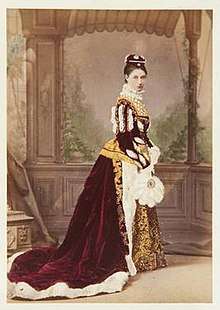Olivia Charlotte Guinness, Baroness Ardilaun
| Olivia, Lady Ardilaun | |
|---|---|
 | |
| Born |
27 August 1850 Macroom Castle, County Cork, Ireland |
| Died |
13 December 1925 Dublin, Ireland |
Olivia Charlotte Guinness, Baroness Ardilaun (27 August 1850– 13 December 1925), a remote descendant of the McCarthy chiefs, was, after the British Monarch, the richest woman of her time in Britain and Ireland.[1]
Life
Born Olivia Charlotte Hedges-White to Jane Herbert and her husband, William Henry Hare Hedges-White, 3rd Earl of Bantry, on 27 August 1850 in County Cork,[2] she was one of six children, five girls and a boy. Her brother became the last Earl of Bantry. Her family had lived at Muckross House, County Kerry since the 1650s.
She married Arthur Guinness on 16 February 1871 at Bantry, County Cork, Ireland.[3] They had no children.[4][5][6]
Ardilaun enjoyed painting, collecting her watercolours in a bound album, and was a member of the Water Colour Society of Ireland. The works include the landscape around Ashford Castle, the family's main home, and views from the family house in suburban Dublin. The couple completely rebuilt the Dublin house, renaming it from Thornhill to At Anne's, as well as arranging a grand addition to Ashford Castle. By the time they were finished it was considered a grand mansion, and hosted the Prince, later King George V, and Queen Victoria. Ardilaun was known for her gardens. and named several roses, as well as having flowers named after her.[7][8][9]
The Ardilauns were known for the lavish parties and great hospitality they showed, as well as their philanthropic nature. Lady Ardilaun worked with the Mercer Charity Hospital as their benefactor and regularly visiting the patients.[10] She also became a patron of the arts and was greatly admired by Lady Gregory.[11][12]
Ardilaun supported the Irish soldiers of the First World War, providing care packages and letters. She kept all the correspondence, providing a great resource to later historians. [13] However, after the death of her husband and the upheaval of the Irish War of Independence and the Irish civil war, Lady Ardilaun retired to St Anne's. Increasingly cut off and isolated by her status and history, she allowed the house to fall into disrepair and in her final years she moved into the Shelbourne Hotel, where she died aged 75.[14][6][1][15][16]
Legacy
Macroom Castle, which belonged to Ardilaun, was nearly destroyed in 1920 along with the town on Macroom when the order was given by Major-General Sir Henry Tudor. Ardilaun was a friend and pleaded with him to spare the town and he deferred to her. However it was later destroyed by Anti-Treaty forces during the Irish Civil War. She sold the castle to a trust for the people of the town.[17] St Anne's house eventually burned down, having fallen even further into disrepair, and the grounds are now Dublin's second biggest municipal park. The organ in the local church of All Saints' in Raheny was donated by Lady Ardilaun along with several stained glass windows.[18]
References
- 1 2 Kevin Corcoran and Teddy Cook. "National Heritage Week 2013: "The Descent of Olive, Lady Ardilaun"" (PDF).
- ↑ "Census 1901".
- ↑ "Irish Genealogy" (PDF). civilrecords.irishgenealogy.ie.
- ↑ "Person Page". Main Page. 2003-09-07. Retrieved 2018-09-17.
- ↑ Bortrick, William (1925-12-13). "The Official Website". Burke’s Peerage. Retrieved 2018-09-17.
- 1 2 "Lady Ardilaun « The Irish Aesthete". The Irish Aesthete « This is not an Oxymoron. 2014-10-06. Retrieved 2018-09-17.
- ↑ Ray Desmond (25 February 1994). Dictionary Of British And Irish Botanists And Horticulturists Including plant collectors, flower painters and garden designers. CRC Press. pp. 303–. ISBN 978-0-85066-843-8.
- ↑ "Botanical Name: Hebe Lady Ardilaun".
- ↑ GREEN CAILIN. "Sunny September Walk in Cong".
- ↑ Michele Guinness (19 August 2017). Genius of Guinness: The Enduring Legacy of an Irish Dynasty. Ambassador International. pp. 153–. ISBN 978-1-62020-704-8.
- ↑ Judith Hill (14 April 2011). Lady Gregory: An Irish Life. Collins Press. pp. 426–. ISBN 978-1-84889-935-3.
- ↑ Robert Goode Hogan; Richard Burnham (1992). The Years of O'Casey, 1921-1926: A Documentary History. University of Delaware Press. pp. 30–. ISBN 978-0-85105-428-5.
- ↑ "LADY ARDILAUN AND THE GREAT WAR. An album complied by Olive Guinness". www.the-saleroom.com.
- ↑ "Irish Genealogy" (PDF). civilrecords.irishgenealogy.ie.
- ↑ Elizabeth Grubgeld (2004). Anglo-Irish Autobiography: Class, Gender, and the Forms of Narrative. Syracuse University Press. pp. 53–. ISBN 978-0-8156-3041-8.
- ↑ Chrissy Osborne (2003). Michael Collins: Himself. Mercier Press Ltd. pp. 84–. ISBN 978-1-85635-407-3.
- ↑ "When Macroom came within a hairs breadth of being burned". Independent.ie. 2010-12-02. Retrieved 2018-09-17.
- ↑ "All Saints' Raheny".